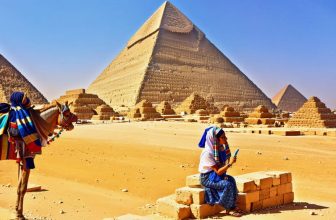When finished, the Grand Egyptian Museum on the Giza Plateau just outside of Cairo (and next door to the Pyramids) will not only be Egypt’s new crown jewel, but also one of the world’s largest, most modern, and most known museums.
Here are some intriguing facts about Egypt’s new Grand Egyptian Museum for individuals who want to understand more about the project’s history and the museum itself.
- The Grand Egyptian Museum’s ceremonial cornerstone was placed in early 2002, although no design or construction firms had yet been chosen to create the new museum complex at this point
- According to the Egyptian government, the main contract for the design of the Grand Egyptian Museum was awarded to the Irish architectural firm Heneghan Peng in 2003 after an extensive international competition, but a team of 300 people from 13 companies in six different countries contributed to the design phase of the project.
- According to the Egyptian government, the main contract for the design of the Grand Egyptian Museum was awarded to the Irish architectural firm Heneghan Peng in 2003 after an extensive international competition, but a team of 300 people from 13 companies in six different countries contributed to the design phase of the project.
The construction of the Grand Egyptian Museum was divided into three stages:
- Phase I was for “enabling works,” which refers to the completion of operations necessary to clear and secure the site and ready it for building development.
- Aside from the main museum structure, Phase II saw the construction of a fire station, an energy center to supply power and air conditioning to the site, and a world-class conservation center.
- Phase III includes site landscaping, the main museum building’s construction, and land excavation and contouring.
- The Grand Egyptian Museum was initially projected to cost $500 million, but delays, revisions, and other factors have increased the complex’s total cost to more than $1 billion.
- A huge statue of Ramses II that was 3,200 years old and had previously stood in the center of Cairo’s Ramses Square traffic circle was one of the first artifacts to be moved to the Grand Egyptian Museum. The 83-ton monument was moved to the conservation center in 2006 despite the fact that the new museum wasn’t even close to being finished at the time. This was done to stop the statue’s degradation due to the pollution that had surrounded it throughout its five-decade tenancy in the square. The monument was moved to the GEM’s main entrance in 2018 where it now rests in peace.
- When everything has been transferred, the Grand Egyptian Museum will house about 100,000 ancient artifacts, including 4,549 items from the famous King Tutankhamun’s tomb in addition to the public on-display collections of the current Egyptian Museum and its much larger private storage areas.
- An estimated 15,000 visitors every day, or about three times as many as the present museum receives each day, are anticipated at the Grand Egyptian Museum. There will be more than 5 million visits per year as a result.
- For more than a century, Tahrir Square in the heart of downtown Cairo has served as the location of the ancient Egyptian Museum, which is approximately a 45-minute drive from the Pyramids, which are situated on the Giza Plateau to the west of the city on the edge of the Sahara Desert. But since the new Grand Egyptian Museum will be just 2 km from the Pyramids, it will be considerably simpler for visitors to go from one to the other and the traffic in Cairo and Giza would be less congested.








